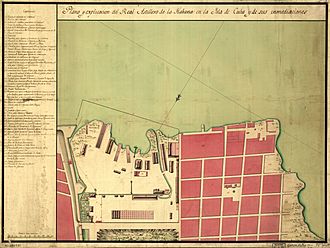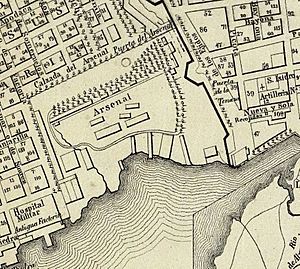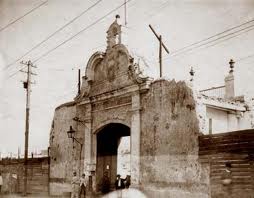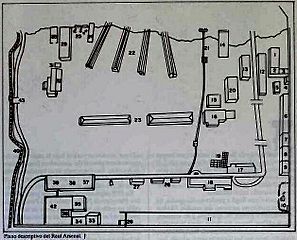Royal Shipyard of Havana facts for kids
The Royal Shipyard of Havana was a very important place in Havana, Cuba, where many ships were built for Spain a long time ago. It was especially famous in the 1700s. During that century, a total of 74 warships were built there! The UNESCO (United Nations Educational, Scientific and Cultural Organization) even said that Havana's Royal Shipyard was the most complete place for building ships in the whole New World during the 1700s.
Where It Was Located
The Royal Shipyard was located in the southeast part of Havana, near a big open space called the Campo de Marte. It was just outside the city's southernmost gate. Today, the Havana Central railway station stands where the shipyard used to be.
This shipyard was quite large, covering about nine hectares (that's like 22 football fields!). A big part of this land was low and sometimes marshy. About five hectares were used to store materials, house workers in barracks, and keep supplies in warehouses. Another two or three hectares were specifically for building and repairing ships. This area had special equipment like davits (small cranes), larger cranes, and docks. There was even a hospital because yellow fever was a common illness. On the south side, there was a small inlet from the coast, which was perfect for launching new ships into the water.
A Look at Its History
The shipyard started with a smaller role, but it became very important when Juan de Acosta arrived in 1717. He was a very skilled shipbuilder. In 1722, he became the captain of the shipyard's main workshop.
Under Juan de Acosta's leadership, Havana truly became a top shipyard. Between 1724 and 1740, he oversaw the building of 23 ships. Some famous ones included the San Juan and San Lorenzo. He also supervised the building of four large ships named after continents: Africa (also called San José), Europa (Nuestra Señora del Pilar), Asia (Our Lady of Loreto), and America (Our Lady of Belén).
Later, in 1748, a naval base from Veracruz (in Mexico) was moved to Havana. This made the Havana shipyard even more important. From 1715 to 1759, about one-third of all ships built for Spain came from the Havana shipyard. In 1735, the shipyard was made even bigger, which allowed it to build even more ships.
Between 1765 and 1789, the shipyard built 62 ships. This included 19 large "ships of the line," which were powerful warships. Five of these were "first class," meaning they had more than 100 guns! Some of these huge ships were the Santísima Trinidad, Mejicano, Conde de Regla, Real Carlos, and San Hermenegildo. The shipyard also built 15 frigates, which are smaller, faster warships.
What Was Produced Here
In the early 1600s, the Spanish King ordered seven large galleons (a type of sailing ship) to be built in Havana. These were for the "windward navy," which protected Spanish ships in the Caribbean. By April 1610, five of these galleons were almost finished and ready to sail.
In 1737, the Royal Trade Company of Havana was started. One of its main jobs was to build ships for both the navy and for trade. This company took over the management of the Royal Shipyard. Because of this, the Royal Company helped a lot to increase the number of warships built for the Spanish Navy. This also helped keep the tradition of shipbuilding alive in Cuba for many years.
Gallery
See also
 In Spanish: Real Astillero de La Habana para niños
In Spanish: Real Astillero de La Habana para niños
- List of buildings in Havana
- Real Arsenal
- Havana Shipyards
- Spanish Empire
- Havana






